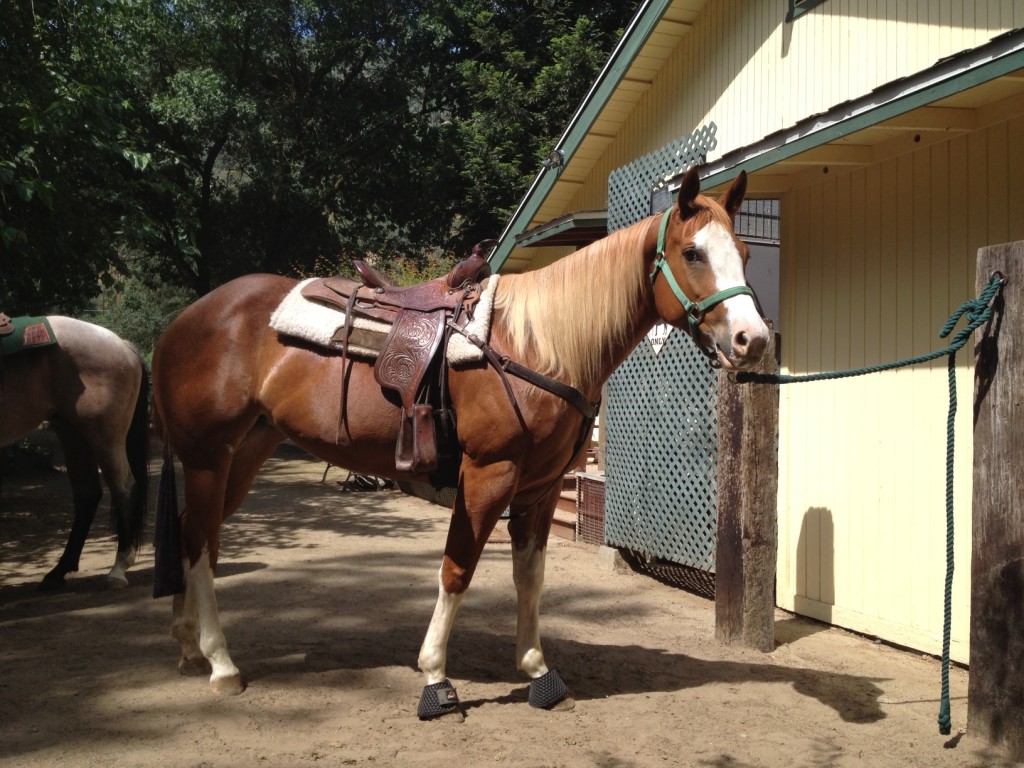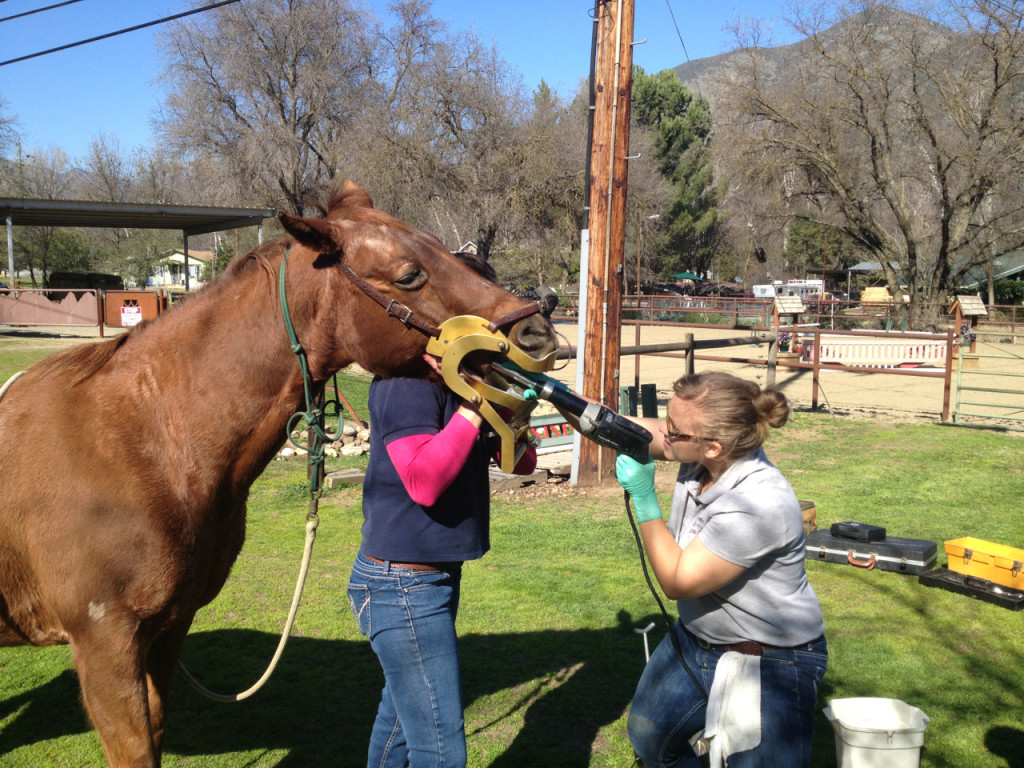
THE PEDESTRIAN’S GUIDE TO WRITING HORSES
5: Care and Maintenance
Horses require a great deal of work, especially if you want to use them in your Quest to Defeat the Dark Lord. The easiest way to care for a horse is to leave it out on a grass pasture with easy access to water. There the horse may graze all day, drink freely, and get enough exercise that it will not go mad. However, the situation of the average horse-owner/protagonist may not allow for this.
The first thing to remember is that horses are natural nomadic grazers. This means the moment you take them off the plains and put them in small paddocks you need to start doing things to make up the difference.
Instead of foraging on grass and roughage all day, the domestic horse is fed hay. Hay comes in many forms, but the most common are alfalfa (high-density, sweet hay; good for performance horses); oat (more fiber, less sweet; better for their digestive system since it takes longer to eat and therefore is closer to the experience of grazing all day); and grass (the mildest hay; horses may eat this all day with no ill effect, but will need to eat more of it to get enough nutrients). As mentioned earlier, all hay today is bound into brick-shaped bales the size of small sofas, which when opened will come apart into flakes. A flake of hay is anywhere from two to four inches thick, and can be comfortably carried in one’s arms—if one doesn’t mind shedding stalks and leaves everywhere as they walk.
Alfalfa has small, hard stalks, but it mostly made up of dried, clover-like leaves. Good alfalfa smells wonderful—almost like tea—and is green on the inside of the bale, while the outside bleaches to a pale gold. It is the densest of all hay, and so is mostly used to feed working horses. The disadvantage is that horses can gorge themselves upon it and make themselves sick.
Oat hay looks a lot like straw, and is about the same color. The crucial difference is that oat hay contains just that: pods of oats mixed in with the stalks and leaves. The flakes tend to be bigger, looser, and in general more messy. Oat hay is less rich than alfalfa, and some horses will disdain to eat the stalks at all.
Grass hay is made up entirely of grass, and fades to a light grayish green. It is the least common in my area, and so I don’t know as much about it. It is even more loose and messy than oat hay, and smells even fainter. I have been told it is the best for horses with sensitive digestive systems, since it more closely replicates their natural feeding habits: eating grass all day.
In addition to hay, a domestic horse’s diet may be supplemented with sweet feed such as oats, oats and molasses, and other concoctions. This is very rich food indeed, and is usually given in amounts of three or less cups at a time, once a day. A horse can easily make themselves very sick from eating too much grain at one time.
Some alternatives to hay include hay cubes or pellets, which are commonly used when traveling—as they are easier to transport.
Today there are also a multitude of supplements that can be added to a horse’s diet to help with joints, coats, hooves, and even temperament. This writer feels a lot of them are only so much magical paprika, but some do contain useful things like mineral oil (which creates a glossy coat and helps with clearing out the hind gut) and iron (helps with red blood cell count, and therefore energy levels).
It is common practice to leave a block of salt available to a horse, especially in hot weather when they will be sweating a lot—and in cold weather, to make them drink more and not become dehydrated. Horses will self-administer as much salt as they need by licking the block. Some people like to use salt blocks with other trace minerals, but I prefer straight salt: a horse needs more salt than anything else, and might get too much of the other minerals if everything is mixed together.
It should be noted that straw is not feed (though a horse may chew on it if bored) and is generally used for bedding. It makes very, very poor bedding. The moment a horse urinates on it it begins to form a fetid mat, and manure is almost impossible to remove without taking huge clumps of straw with it. Better kinds of bedding for stables are dry wood shavings or pellets; better yet is plain, dry sand. However, all stalls suffer from the excrement of horses and must be cleaned every eight hours or at least once a day if they are to be kept decent—unless they are exceptionally well engineered, which they never are.
Horses drink a lot of water, especially in hot weather. They must always have access to water when at home, either by manually filled barrels, self-refilling troughs, or even natural streams.
There is a lot more to the day-to-day keeping a horse, but this should be enough to get you by for any story that does not revolve around said keeping of horse.
In addition, horses require regular hoof-care. In the wild their hooves are naturally worn down by the constant pounding over hard ground. But even the hardest-working domestic horse needs its feet trimmed every so often. How often depends on the horse and the type of work they are doing. Every six to eight weeks is the average, though some schools of thought follow the principle of trimming the horse’s feet a tiny little bit every couple of weeks.
A horse may be half-shod (metal shoes on their front feet only), full-shod (metal shoes on all four feet) or barefoot (no shoes). Having shoes on the hind feet only is almost unheard of, unless the horse has some sort of deformity in their hind feet alone that requires corrective shoeing. Even then, this is uncommon: the majority of problems occur in the horse’s front feet, which bear the most weight.
Horse shoes come in a great variety of sizes and shapes. They are held on the horse’s hoof with small nails driven through the outer edge of the hoof wall. A correctly attached shoe causes a horse no pain. An incorrectly attached shoe can cripple a horse. Consult the nearest farrier if you wish to have your ear talked off. I actually recommend this: farriers are interesting people and usually have some great stories of their own to tell.
Though as a general rule a horse is better off with shoes on when presented with rough terrain, some horses don’t take well to shoes: their feet grow strangely, or do not grow at all, and very soon you run out of places to put the nails. Even without shoes, there are still a myriad of ways to trim a horse. Contact a bare-foot trimmer (or bare-footer) again, for an earful. Barefoot horses will do better over stone (less slippage) and snow. They will also have better circulation in their feet, and therefore better hoof growth.
Note: metal shoes are terrible in snow. The snow will freeze and stick to the cold metal, clumping up into icy balls and making it impossible for your horse to walk.
A modern compromise is to have a barefoot horse, and outfit them with rubber boots when they are taken out to be ridden. This barefoot-and-boots approach is fairly new, but it is not unimaginable that someone might have thought of it before.
It is typical for a horse to receive a visit from a veterinarian once a year for a checkup. The vet will look them over for signs of disease, give them what booster vaccines are due, and float their teeth if necessary.

Ah yes, teeth floating. And you thought going to the dentist was bad.
Horse teeth grow constantly because they are meant to be worn down by near-constant chewing. A horse on a diet of soft alfalfa hay, therefore, will not be chewing enough to counter their tooth growth. Oat hay and grass hay, again, are better, as they take longer to chew. Even so a horse can develop uneven wear patterns that result in nasty spikes, hooks, and waves that can cause serious problems if left unattended. To prevent this the vet will take a rasp and manually grind down the horse’s offending teeth. In doing so they usually check for rotting teeth at the same time. Because their natural diet contains almost no refined sugar, horses generally do not suffer from cavities or infections. When they do, however, it can be a very bad thing and you want to know about it right away.
Today vets have all sorts of elective grinders and rasps, and will sedate the horse so they can more easily do their job. But I’ve seen it done with a hand rasp by a 130 lb. woman on a horse with only a halter and twitch (a sort of clamp that holds on to the soft tissue of the horse’s upper lip, and gives them more of an incentive to hold still). It was quite a sight.
Vets may also be called in at any time to treat lameness, illness, or AFR (“Ain’t Feelin’ Right”), but that is a matter for the next chapter.
Horses are usually given “wormer” regularly to combat the growth of parasite larvae and eggs in their intestines. These are made from a variety of compounds, most commonly ivermectin. Horses contract the eggs from eating contaminated food, so a horse on a large pasture is usually better off. When given the choice, horses will not eat food that has been anywhere near their dung, but a horse in a small paddock usually has no choice.
A horse being ridden requires grooming every time it is used. Stiff-bristled brushes are used to brush their fur, cleaning it of dust and dried mud. You may also brush their manes and tails with a human hair brush. Most importantly, they need the soles of their feet checked and cleaned before and after riding. This is done with a hoof pick; a handy metal hook like a crooked finger attached to a handle.
Horses may be given treats. These usually take the form of carrots, apples, and handfuls of grain. They will also eat cookies and peppermints, if given the opportunity. However, all treats must be fed in moderation, or else you risk hurting the horse.
There is a lot more to the care of horses than what I have described here; but it’s enough for now. If you need to know more than this for your story, it is time to get a horse of your own and learn from experience.
In the next chapter I will go over the most common ways horses injure themselves, and how one might respond. Ever wonder why racehorses who break a leg get euthanized? I explain how that works, too.
On to Chapter 6: Illness and Injury ->
Goldeen Ogawa has been working with and around horses since she was five years old, has been a horse-owner since 2000, and currently rides every week. If you have any questions about horses not answered here you can email her at goldeenogawa@gmail.com or peck at her on Twitter @GrimbyTweets. There you can also follow her weekly horse pictures under the #TweetsFromHorseback hashtag.


























